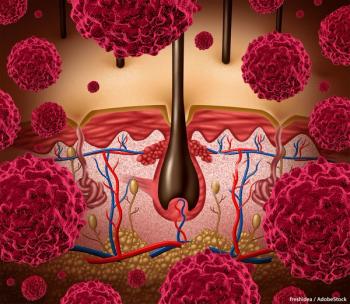
BRAF-MEK Inhibitor Combo Extends Survival in BRAF-Mutant Melanoma
The combination of encorafenib and binimetinib resulted in longer overall survival compared with vemurafenib in patients with BRAF V600–mutant melanoma.
The combination of encorafenib and binimetinib resulted in longer overall survival (OS) compared with vemurafenib in patients with BRAF V600–mutant melanoma, according to results of the COLUMBUS trial. Combined with an earlier report showing improved progression-free survival (PFS), this suggests the regimen should become an important option in this setting.
Small-molecule BRAF inhibitors, originally introduced as monotherapy, offered improvements in outcomes for these melanoma patients. “However, response durations were short and BRAF inhibitor treatment was associated with the development of squamous cell skin cancer and other skin toxicities related to paradoxical MAPK pathway activation,” wrote study authors led by Reinhard Dummer, MD, of
The trial had three arms, including patients receiving encorafenib plus binimetinib (192 patients), encorafenib alone (194 patients), or vemurafenib alone (191 patients). All patients had locally advanced, unresectable, or metastatic cutaneous melanoma with a BRAF V600 mutation.
After a median follow-up of 36.8 months, the median OS was 33.6 months in the combination group, 23.5 months with encorafenib monotherapy, and 16.9 months in the vemurafenib group. Compared with the vemurafenib group, the encorafenib plus binimetinib group had significantly longer OS, with a hazard ratio (HR) of 0.61 (95% CI, 0.47–0.79; P < .0001). OS did not differ significantly between the combination group and the encorafenib monotherapy group, with an HR of 0.81 (95% CI, 0.61–1.06; P = .12). OS was better with encorafenib alone than with vemurafenib, with an HR of 0.76 (95% CI, 0.58–0.98; P = .033).
At 1 year, the OS rate was 75.5% with the combination therapy, 74.6% with encorafenib alone, and 63.1% with vemurafenib. At 2 years, those rates were 57.6%, 49.1%, and 43.2%, respectively.
A total of 29 patients (15%) in the combination group required study drug discontinuations due to adverse events, compared with 15% in the encorafenib monotherapy group and 17% in the vemurafenib group. Adverse events leading to dose adjustments were reported in 54%, 71%, and 62% of the 3 groups, respectively.
“These data provide a new benchmark against which new BRAF-MEK inhibitor therapies for BRAF-mutant melanoma can be measured,” the authors concluded. “Together with a favorable tolerability profile, encorafenib plus binimetinib could become an important new treatment option for patients with BRAF-mutant melanoma.”
In an accompanying
“The outcomes observed with encorafenib plus binimetinib provide good news for patients with advanced BRAF-mutant melanoma, but there is probably no need for additional novel BRAF-MEK inhibitor combinations,” wrote Martin-Liberal. Instead, future study in this setting should focus on sequencing of therapies, or defining the optimal duration of treatment.
Newsletter
Stay up to date on recent advances in the multidisciplinary approach to cancer.





















































































